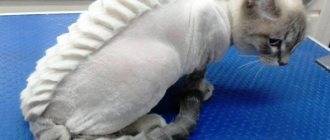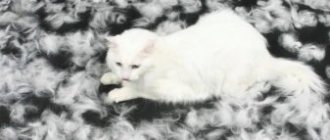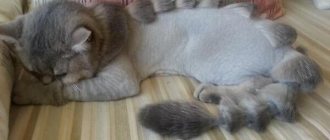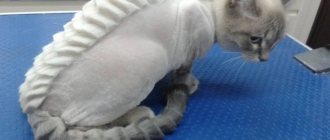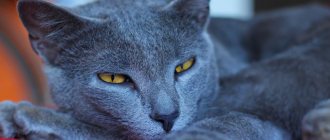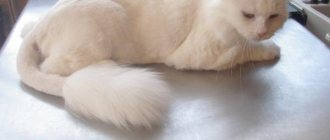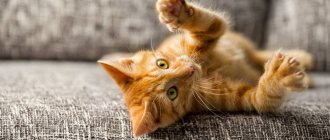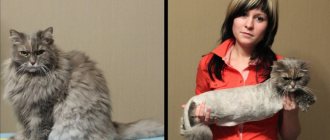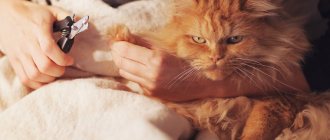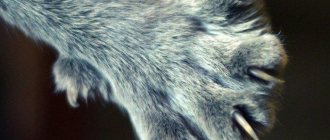Grooming a domestic cat on your own is a very difficult and responsible task. For a handsome furry cat, such an event, conducted illiterately and unprofessionally, can turn into real stress. If you still decide to do the haircut yourself, without the help of a professional hairdresser and at home, then you should first familiarize yourself with the recommendations of professionals so as not to harm your pet.
Required Tools
A hygienic grooming of a furry pet can be done using only scissors as the main tool. Naturally, they should have rounded ends, be well sharpened and not very large in size.
But it is preferable, of course, to use a trimmer (a special hair clipper). It is completely safe and you won’t be able to inadvertently injure your pet, and it does the job much faster and easier. The only problem that can become an obstacle is the noise the machine makes. Your pet may get scared of the device and simply run away. There are regular trimmers and ones for hard-to-reach places.
Additionally you will need:
- Comb with rounded teeth to avoid scratching the animal.
- Hydrogen peroxide and cotton wool in case you accidentally injure your pet.
- Bedding, for example, an old towel, which will have to be thrown away after the event.
- A table or couch is any horizontal surface where you can comfortably place your cat.
- A distracting object that the pet can engage in during the procedure, for example, a toy, a dental bone.
Which machine to choose for grooming a cat
Retail chains offer a very wide range of devices for grooming pets, from very expensive and functional to budget ones. The disadvantage of inexpensive models is, first of all, their unstable and indelicate operation - such models can cut fur poorly or pull out hair. Another disadvantage of budget models is that they overheat during use, and you can simply burn your pet. Inexpensive trimmers have a short service life.
As mentioned above, there are regular trimmers and ones for hard-to-reach places. The latest models are distinguished by their small size and shorter blades (no more than 2 cm). A similar device can be used to treat areas of anatomical curves, ears, muzzle, and areas under the tail. But this is more of an auxiliary tool; it is impossible to give a full haircut with it. Conventional trimmers are used for these purposes.
For representatives of especially fluffy breeds with a thick undercoat (Persians, exotics, etc.), choose devices with a power of at least 45 W, they will not overheat and can cope with thick hair. Pay attention to the blades: they should be wide and sharp. The speed and delicacy of the work depends on the sharpness of the blades. For cats with not very thick and long hair, you can use clippers with a power of 20 W or more.
A very useful option for the trimmer is the ability to automatically adjust the cutting surfaces. When choosing a device in a store, pay attention to this; not all models have this function. With a minimum length of cutting surfaces of 0.5 cm, the length of the pet's hair after cutting will be equal to 0.5 cm. It is dangerous to use devices with very small blades yourself at home - you can injure the animal's skin.
Mains-powered electric trimmers are preferable to those that rely on batteries or a battery. They guarantee stable and long-term operation of the device. If you frequently have to pause and turn off the device while cutting, the battery or batteries may drain very quickly. An even more convenient option is models that have both a battery and a network connection. The noise level produced by the device is also important. The quieter and more pleasant the device is, the more the cat will like it.
Make sure that the machine is comfortable to hold in your hands. It should be moderately light and moderately heavy. It is difficult to ensure smooth movement with a device that is too light, and a device that is too heavy will quickly tire your hand. Therefore, try to find a “golden mean”.
Pay attention to the shape of the handle; it should fit comfortably in your hand and not slip out.
Be sure to check the device before purchasing, especially for overheating and foreign odors.
Grooming a fluffy cat at home (step by step)
The order of manipulations when performing a self-grooming of a long-haired cat is as follows:
- Working tools must be disinfected before use.
- Then you should put “anti-scratch guards” on your pet’s claws (special silicone caps) or trim the claws. To trim, use special nippers, which are available in any pet store - “claw clippers”. Gently press down on the cat's paw and quickly cut off the claws. If the edges turn out uneven, you can trim them with a nail file.
- If your pet is unfamiliar with the procedure and you are not confident in your abilities, it is better to invite an assistant: he will hold the pet and distract him. To protect against bites, place a plastic Elizabethan collar on your cat.
- You can begin the procedure only after the cat is comfortably positioned on its side on the table surface and its paws are securely fixed.
- The haircut starts from the sides. There is no need to rush and be nervous, otherwise your anxiety will be transmitted to your pet and he will also begin to behave restlessly.
- The next stage is the back and stomach. Be careful when handling the stomach. There are mammary glands that can be easily injured. The trimmer movement can be carried out both in the direction of hair growth and in the opposite direction.
- If unnecessary hairs remain after using the trimmer, they can be removed with scissors.
- During the treatment process, try to slightly pull your pet's skin to minimize the risk of cuts. This is especially recommended when the work is done with scissors.
- The tail may be left uncut when trimming is performed for hygienic purposes. But, when the animal is preparing for an exhibition, you can cut it, leaving only a nice tassel at the tip of the tail. It is better to treat the ponytail with a trimmer.
- Upon completion of the haircut, the pet should be washed in warm water with the addition of zoo shampoo and dried. You can use a hairdryer set to a gentle setting with moderate heat.
It's up to you to choose the main tool for cutting your furry pet's hair. At the same time, keep in mind that the trimmer does not always do a good job, and after it you will still have to trim your hair with scissors. And working only with scissors is more dangerous for the cat and significantly lengthens the process, although it guarantees a more attractive appearance for your beauty. The trimmer can only be used dry! Do not wet the fur under any circumstances if you are going to use an electric trimmer. On the contrary, when working with scissors, it is recommended to slightly moisten the wool, spray it with a spray bottle and distribute the moisture over the wool with a comb. This makes the cutting process easier. It is not recommended to cut your hair too short, regardless of the breed. Firstly, a haircut that is too short carries the risk of injuring the animal’s skin during the procedure, and secondly, after the haircut, the pet’s normal thermoregulation must be maintained and it should not freeze.
Types of grooming
Depending on the goals pursued by the owner, the following types of grooming can be distinguished:
- Hygienic. The animal is bathed, its eyes and ears are cleaned, its claws are trimmed, and its teeth are brushed. The wool is cut in the groin area and on the stomach so that it does not get dirty so much. Trim the hairs between the pads and fingers.
- Home. This type includes all the procedures that the owner carries out with his pet at home: combing the fur, trimming the claws, cleaning the eyes and ears, bathing. In addition, the owner can cut off the tangles formed on the cat’s fur himself.
- Exhibition. Although it is not recommended to bathe cats frequently, they are thoroughly cleaned before exhibitions. In addition, the cat can be given a neat haircut, which is necessary to emphasize all the advantages of this animal and give the coat a neat appearance.
- Creative. Cats are given rather unusual hairstyles, cutting out entire patterns and giving their fur an unusual look. It is not advisable to do this for “beauty”, but if the animal needs a haircut in any case, then its fur can be given an unusual shape.
We recommend the article: Traveling with a cat: important tips for trips and trips
How often should a cat be groomed?
If the procedure is carried out for hygienic purposes, then the frequency of its implementation depends largely on the breed and quality of the hair. A cat's hair grows completely in about six months. Experienced breeders and veterinarians recommend hygienic grooming of furry pets two to three times a year, and removing tangles that appear in between with scissors.
You should not carry out this procedure too often. You need to be especially careful in the winter season. Animal fur has a protective function. The most optimal thing is to trim your furry pet before the onset of the hot season, since long-haired felines have a hard time withstanding the summer heat.
You should not force a haircut on a pet who is wary of the event. In such a situation, you can contact a veterinary clinic. The clinic’s specialists have extensive experience working with various animals, they know very well how to calm a cat, remove the aggressive background in its behavior, and carry out the procedure as safely and quickly as possible.
Is it possible to shave?
A domestic cat that is not allowed outside by its owner can be shaved. In other cases, such a procedure is not necessary, as it is useless. Thanks to excellent thermoregulation, even a long-haired cat feels good in hot and cold weather, but trimming and shaving can disrupt it. Some very clean owners consider it right to shave their cat bald during the shedding period, but this does not solve the problem, since the hair grows and falls out as often as that of an unshaven animal, differing only in the length of the hairs. It is possible to shave and trim cats in winter, but until the fur grows, the animal is not allowed to leave the house to go outside. A short-haired breed, such as a Scottish cat, can benefit from simply brushing.
Return to contents
How does a cat change after a haircut?
After a haircut, you may see changes in the animal's appearance and behavior.
- External changes are possible: a change in the previous shade of the coat in one direction or another (darker, lighter), a change in the quality of the coat (thicker, less frequent), a change in the rate of hair growth.
- Among the internal changes, you may have to deal with new behavior of your pet, especially if the event was held in a nervous environment, the cat was scared, or experienced stress. The animal may become fearful and stop trusting its owner.
At first, your pet may feel cold, even if the weather is hot outside. For such an occasion, prepare blankets or buy your animal a sweater.
Additional services
In addition to getting a haircut in a grooming salon, you can ask the groomer any questions you have about caring for your cat. You are also provided with a list of various additional services :
- Combing mats without cutting – 1000 rubles or 200 hryvnia.
- Hair trimming around the anus and genitals, as well as treatment with anti-inflammatory drugs - 500 rubles or 100 hryvnia.
- After cutting, wash and dry the cat’s fur – 600 rubles or 100 hryvnia.
- Cleaning of ears and eyes – 200 rubles or 30 hryvnia.
- Trim claws – 200 rubles or 40 hryvnia.
Whether you should trim your cat yourself or with the help of professionals is up to you. The main thing is to take care of your pet in a timely manner, monitor its health and consult a veterinarian before grooming.
What to do if you accidentally hurt your pet?
Even with the most careful procedure, an unpleasant situation is possible when you injure the animal. You need to prepare for this and always have the necessary disinfectants on hand (peroxide, brilliant green, iodine), as well as cotton wool. It is necessary to treat not the wound itself with a disinfectant, but the skin around it. Treat the cut site in such a way as to stop the bleeding. Calm and caress the animal; in this case, you can prepare some kind of treat that will distract the pet.
There is no need to be nervous or lose your composure. Your anxiety will be transmitted to the animal, and the cat will begin to panic. Moreover, it is unacceptable to shout at a cat or use physical methods of influence. The procedure can be carried out further only when the animal has completely calmed down and allows manipulation to continue.
Carrying out a hygienic haircut for your furry pet yourself is a completely doable task. Hygienic care is necessary to ensure that your pet looks neat, well-groomed and does not suffer from the heat in the summer. But, if a fluffy cat is preparing to go out into the world, for example, to an exhibition, it is better to contact a grooming salon or veterinary clinic. Professionals will do the job more efficiently and decoratively. The only thing you need to pay attention to is that during the procedure, veterinary clinics usually use light anesthesia or give sedatives. It's not entirely harmless. If your furry pet behaves calmly, you can refuse to use these products.
Do you like the article? 77
Benefits and harms
Like any grooming procedure, cat trimming has its positive and negative properties. Let's look at them in detail.
Pros:
Relief from heat and health problems. There is a very common stereotype that representatives of long-haired breeds suffer from heat, especially during the hot season.- It is necessary to cut a cat if for some reason (for example, due to age) it cannot care for its fur, and you do not have the opportunity to constantly care for it. All this can soon lead to a visit to the veterinarian, and in worst cases, to surgery.
- Caring for a cat can also save the lives of owners who suffer from allergies or asthma. It will help eliminate the factor leading to suffocation and exacerbation of the disease.
Minuses:
- Many cats have a negative attitude towards haircuts. It, like bathing, causes discomfort and stress for the cat. After this, the pet may be depressed, and due to resentment, it may even become offended and ignore the owner. Particularly proud pets can leave a “surprise” in their owner’s slippers in retaliation for an attack on their fur coat.
- After cutting, the cats' hairs become a little smaller. Even the color of the animal may become lighter. If the coat is shortened too much, the animal will feel unwell and may experience dryness and loss of elasticity.
- There are cases when in some areas of the skin the hair does not grow back after cutting. This means that alopecia appears. This is caused by hypothermia and improper hair growth. This condition is mainly characteristic of dogs, but there have been cases when it also occurred in cats. If baldness began to appear even before the cut, do not try to solve the problem: here you need to contact a veterinarian.
